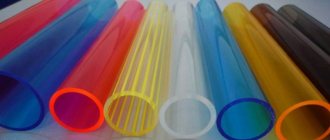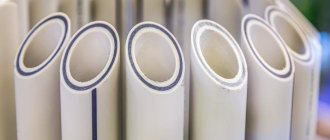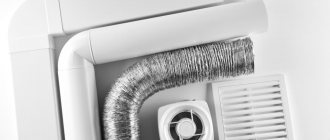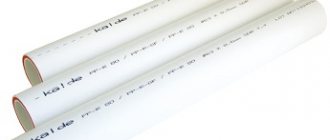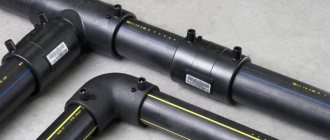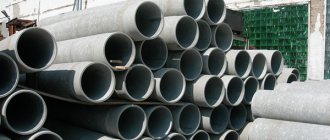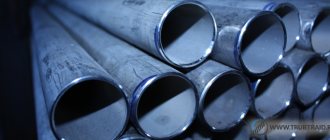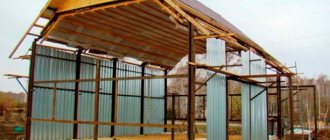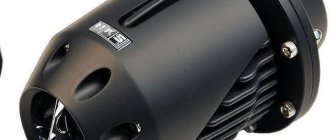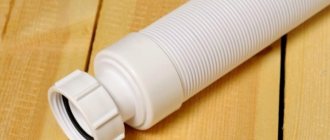Transparent PVC tube is a universal part of non-pressure pipelines. Due to its many advantages, it is very popular in the plumbing market. It is used both for commercial and industrial purposes, and even for domestic purposes for transporting liquid substances. What are its main pros and cons? What are the specifics of this product? When can it be used and when should it not be used?
Transparent PVC pipes are used for water supply, ventilation networks and laboratory equipment
Characteristics
The performance of transparent polymers is higher than that of glass. One of them is elasticity, although there are also fragile transparent plastic materials. But first things first.
Strength
The strength indicators of PVC pipes depend on their purpose. Transparent pipes are not used in pressure systems and are not designed to resist internal pressure. But they are resistant to mechanical stress and stretching.
Their hardness and tendency to scratch are low; such pipes require a protective layer. This is almost the only factor in the “disadvantages” column. Their many advantages and the fact that they are impact-resistant expand the scope of application of plastic transparent pipes.
Light transmittance
Products made of transparent plastic have high light transmittance - slightly lower than glass. It can reach up to 92%, and the transmission of ultraviolet rays up to 73%. With special coating, transparent plastic blocks ultraviolet radiation.
Resistance to external factors
Transparent plastic material has low water absorption. Resistant to penetration of odors and biological microorganisms. Mold and bacteria do not grow on a plastic pipe, and fungi do not take root.
Withstands prolonged exposure to temperatures not exceeding +60 ˚С, although it begins to lose properties already at +40 ˚С. The melting point of transparent plastic is 160˚C, fire can start at 260˚C. It burns reluctantly and releases methyl methacrylate when burned.
Chemical inertness
The transparent plastic pipe is resistant to many acids and alkalis. But it can be damaged by hydrochloric and concentrated nitric acids. Hydrofluoric acid in diluted form is also dangerous. Plastic can be dissolved in chlorinated hydrocarbons, acetone, and alcohols.
The high inertness of transparent plastic material to hydrocarbons, oils, and fats makes it often used in the food and medical industries.
Areas of application
The low cost and ease of processing, resistance to corrosion and aging of the material makes it applicable in many areas. Transparent pipelines are used in robotics, where plastic pipes are a kind of “plumbing” for colored liquids. And with the development of LED technology, where the light source hardly heats up, they are becoming widely used in garlands of advertising equipment.
Lighting devices
Due to the ability of transparent plastic pipes to diffuse light and transmit it highly, they are widely used in lamps, table lamps, lanterns and neon lighting.
Interior design
The widest use of transparent plastic pipes is in repair and design. Thanks to multi-colored LEDs, pipes are used to illuminate design elements in the interior of buildings and premises.
Advertising signs and colorful decoration of building facades are rarely complete without transparent plastic.
Electronics and computer industry
A transparent plastic tube is often used as a cambric. This is an elastic fragment that is put on the wires at the point of contact or soldering for insulation. Its transparency allows the service operator to evaluate the contact connection when inspecting and regulating electronic equipment.
The described material is used in various electronic computer devices that deal with liquids. For example, liquid analyzers, synthesizers, 3D printers.
Products
These transparent products transmit light very well, almost like regular glass, only two percent less. Many interior designers take advantage of this advantage. For example, interesting lamps and LED lamps are made from polycarbonate pipes. Such products decorate the windows of many shops and supermarkets in big cities. Thanks to polycarbonate, in every corner of the civilized world, shopping centers glow with thousands of lights at night. Also, these specific lighting fixtures are part of the design of almost all nightclubs.
You can also make from polycarbonate pipes:
- unusual and original railings for stairs;
- shock-resistant cases for gifts;
- elements for pneumatic mail.
Some enterprising people use them to make expensive souvenirs.
What materials is it made from?
The properties of plastic pipes directly depend on the material from which they are made. Although sometimes you can’t tell them apart by appearance, the difference in characteristics is noticeable. Therefore, I propose to consider the properties of polymers.
Polycarbonate
This is a lightweight and durable material. Its specific gravity is 1200 kg/m³, which is 2.5 times lighter than glass. Polycarbonate is easy to process; it can be cut, drilled, sharpened, and polished. It will not crack even if you screw a self-tapping screw into it. Another advantage is fire safety.
Polymethylmethacrylate, or plexiglass
It is called PMMA for short, or plexiglass. The second name appeared due to the high light transmittance - up to 0.92. For ordinary glass, this coefficient ranges from 0.9 to 0.85, so plastic even surpasses it. The impact strength is 5 times higher, the specific gravity is 2.5 times lower than glass. But even when broken, plexiglass does not pose as much danger as glass.
Polyvinyl chloride
It is a soft and flexible material that is inferior in strength to all other transparent plastic substances. And although it has a small range of operating temperatures, from – 15 ˚С to + 60 ˚С, it is very widespread.
The disadvantages of this material are the destructive effects of ultraviolet rays on it. This limits its use outside buildings, where, in addition to ultraviolet radiation, there may be a temperature below - 15 ˚С, which also has a detrimental effect on it.
Installation features
PVC tubes are used in many sectors of the economy - from laboratory units to milking machines. Their specificity is that they are used in cases where visual control over the transportation of a substance is needed.
Despite the fact that the transparent tube is easy to use and install, you should not forget about some points regarding the installation of the equipment.
A significant advantage of a pipeline made of polyvinyl chloride is its simplicity of design. You will need a minimum of supplies and equipment, and the procedure itself can be carried out independently. PVC is a fairly rigid material. This makes it similar to metal and affects the technology of pipe laying. For calculations and drawing up a system plan, you can use data for iron analogues.
Installation of transparent PVC pipes is possible using both open and hidden methods, since they are made of material that is resistant to the negative effects of ultraviolet rays. In addition, they are sometimes produced with the addition of a layer of protection against oily substances and gasoline.
The algorithm of installation actions itself is not complicated. You just need to select pipes of the correct diameter, connect them using fittings and special corners at the turning points.
Production technology
Clear plastic pipes are made in two main ways: casting and extrusion. The press uses pressure to force out plastic material heated to the point of melting. Special holes allow the pipe to be formed at the initial stage. Next, the device pulls out the cooled part of the pipe.
This method allows you to make long pipes, and if the material is flexible, then wind it into rolls. For example, PVC pipes are manufactured and wound into coils, where the length of the pipes is kilometers.
Pipe casting using the seamless method is carried out using special centrifuges. The molten material fills the mold, which rotates at a certain speed. Centrifugal force evenly distributes the molten polymer before it cools, forming a pipe of the desired diameter.
Brands of lighting plexiglass
At the moment, manufacturers offer a lot of varieties of lighting plexiglass, which are divided into brands:
- SE – extrusion, that is, produced by extrusion from polymethyl methacrylate on an extruder line.
- SB is a block plexiglass sheet type with strong intermolecular bonds. The production process involves pouring molten monomer between two planes and subjecting it to further polymerization.
- SEP – extrusion, characterized by transparency.
- SBS is block-based, but difficult to burn.
- SBPT – block with increased heat resistance.
Among all the listed brands, only SEP is highly transparent. The rest of the lighting materials are cloudy.
Advantages and disadvantages
The only competitor to transparent plastic pipes is glass: in terms of mechanical and chemical properties, plastic products are not inferior to it. And in the field of design they even compete with crystal. In any case, products that imitate crystal benefit in price.
According to its physical characteristics, plastic has the following advantages:
- Not fragile. Even when some of its types crack, they do not form dangerous fragments.
- Easy. The specific gravity is significantly higher than glass.
- Relatively cheap.
Flaws:
- Small temperature range.
- The material is scratched.
- Some species may fade, turn yellow or become cloudy, or crumble when exposed to the environment.
Advantages of ordering at PLAST.RU
The PLAST.RU online store positions itself as a reliable seller of various plastic products and related materials. Our experience allows us to guarantee customers the high quality of all products offered. By purchasing from us, you receive:
- A wide range, from which you can easily select the material that will be relevant for purchase according to certain criteria.
- Complete information about the product with its characteristics.
- A convenient form for sorting materials according to selected criteria.
- Possibility of receiving remote assistance.
- Fast order processing.
- High-quality delivery by qualified specialists, which guarantees the safety of purchased products throughout transportation.
- Great prices that rival other alternatives.
- Well-established work with suppliers due to which the goods are always in stock.
- Possibility to purchase products both wholesale and retail.
- Having our own warehouse, to which, if necessary, the customer can drive up and pick up the ordered items independently after inspecting them.
How to choose
When choosing pipes, it is necessary to take into account their characteristics. These are temperature range, strength, impact resistance, flexibility and crackability.
If the plastic material requires further processing, then it is better to use polycarbonate. And if you just need decorative transparent pipes indoors, then use polyvinyl chloride. If the temperature range does not allow its use, then plexiglass is chosen.
The manufacturer is also important. Nowadays, a branded product does not mean expensive. It’s just that branded manufacturers produce their products on high-tech equipment using innovative technologies. It can even reduce the cost of the product while increasing its quality. Qingdao Eastop Plastic, Hebei Orient Rubber & Plastic, Borrex, Sotalight, SUNNEX have a good reputation.
What is a PVC drainage system?
Polyvinyl chloride (PVC) is one of the most common materials of our time, used in almost all sectors of our life. The construction industry has not been left behind, and along with vinyl siding, polymer drainage systems have also appeared on the market. All components are connected through grooves; rubber seals are used to seal the seams to prevent leakage. Like a metal, polymer drainage system consists of several main elements:
- gutter;
- drainage funnel;
- drainpipe.
The system also includes accessories such as connectors, corner elements, plugs, brackets and other accessories.
When the first polymer systems appeared on the market, they were positioned as drains for small buildings - outbuildings, gazebos or compact country houses. With the development of this direction, the scope of their application has expanded significantly; now it includes residential and industrial buildings of any scale with roofs of various configurations.
